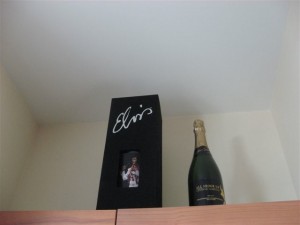Drink Like An Egyptian
Who knows if King Tut was given to tippling, but when his tomb was opened in 1922, three dozen plain pottery wine jars were discovered inside, twenty-six of which had hieroglyphs telling of the vineyard location, the estate where it was produced, and the vinter who produced it. Two pots were labeled “very good.” Tut died in 1352 BC, and perhaps the labels were the first, or almost the first, examples of things to come in the world of labels. A few of the wine jars in the tomb were empty. Or perhaps laced with poison, who knows?
 My personal favorite label, is pasted in my Cooking of Provincial France cookbook, circa 1968. The label from a Beaujolais Saint-Amour burgundy produced by “Jaboulet-Vercherre,” is square, designed in tones of burgundy, white and metallic gold. Stamped “JV,” it includes a coat-of-arms bannered “in tenebris lumen rectis,” which means, “true light in the darkness.” I drank large draughts of the Beaujolais while mastering the art of whipping up Coquille Saint-Jacques a la Provencale, which incidentally, is best served with a dry white wine. Dude, peel me a grape.
My personal favorite label, is pasted in my Cooking of Provincial France cookbook, circa 1968. The label from a Beaujolais Saint-Amour burgundy produced by “Jaboulet-Vercherre,” is square, designed in tones of burgundy, white and metallic gold. Stamped “JV,” it includes a coat-of-arms bannered “in tenebris lumen rectis,” which means, “true light in the darkness.” I drank large draughts of the Beaujolais while mastering the art of whipping up Coquille Saint-Jacques a la Provencale, which incidentally, is best served with a dry white wine. Dude, peel me a grape.
Paper labels as we know them today, weren’t developed for general use until around 1860, when manufacturers understood how to make them stick to glass. Prior to that, well-heeled households used silver “bottle tickets” hung by narrow silver chains from wine decanters. In the 1740s, European wineries sold their products unlabeled. They were stored stacked in bins and the bins were then identified with glazed pottery tags. Labels were designed to inform. Consider this from a late 1800s bottle of sweet red Tokay from Hungary:
This wine having been stored in wood for the full period necessary for maturity, and all unwholesome acids being thereby eliminated, is safely included in the dietary scale of the invalid; whilst its fine delicate bouquet will please the taste of the connoisseur.
Makes you want to drink yourself stupid doesn’t it? In 2001, an image of Mona Lisa sporting a red mustache took first prize in a label-making content hyped by Wine Maker Magazine An obvious rip off of “Got Milk” campaign, I wonder if it bombed?
Anyone who shops for wine, knows it’s the label that grabs the eye and it’s the label that clinches the sale. Face it, it’s where “art meets commerce.” The youth of today now drink more wine than beer, and yes, these are the youths who grew up with television, digital graphics, People Magazine, and clothing “branded” with labels.
Come on now, who wouldn’t want a bottle of “Marilyn Merlot,” named after Marilyn Monroe who died way back in 1962. She’s there on the label in living color…head thrown back, rosy lips parted to reveal pearly teeth. Her famous eyes are partially closed. Clad in a ribbed white tank-top; a delicate necklace dripping seal shells and polished stone hangs around her famous neck. A wine expert claims Marilyn Merlot (2003 Napa Valley Winery) is “middling,” and it’s suggested that perhaps connoisseurs should sip the 2003 “Velvet Collections” labeled with photographs taken of her in 1949, photos which eventually became the centerfold for the inaugural edition of Playboy Magazine. The labels have Marilyn posed on a red velvet drape, naked as a jaybird, but uh oh, they’ve been altered to include glittery red sashes designed to disguise her breasts and pubic area.
And lest we forget all those “animal” labels, the Aussies are leaders of the pack with leaping ‘roos. Black swans abound and penguins too. “Fat Bastard” labeled with a fat hippo, lines shelves where labels of snarling bears, dancing bulls, and whoa! a bottle of “3 Blind Moose,” showcases a trio of moose wearing dark glasses. A 2005 Chianti embellished with an angelic daVinci image, is way different than the spatula-wielding dame (wearing cats-eye glasses, too much jewelry and a pink frock), stuck to the front of a bottle of “Mad Housewife.” The manager of one liquor emporium apologized profusely that he didn’t have any Marilyn Merlot, so I settled for a bottle of “Frontier Red,” replete with a coonskin wearing Fess Parker.
When last I checked, Wisconsin lagged somewhat in the art of wine labels. Most were boringly bland, with small boring drawings of various fruits (blackberry, raspberry, sweet cherry and cranberry). Another state vineyard made a stab at fame with their “Big Stuff Red” label, with a blonde toddler admiring a bunch of grapes. The Milwaukee Art Museum, a bastion of things arty, has its very own designer wine, produced by Door County’s Stone’s Throw Winery. The label features the Calatrava addition. Charles Allis Museum has its own ale labeled “Allis Ale.” But I digress.
 On the tip top shelf in my kitchen is an impressive bottle of “All Shook Up” Sauvignon Blanc. I doubt if The King swilled this with his peanut butter sandwiches, though maybe he used it to wash down pills. Graceland Cellars, a spin-off of Elvis’ Memphis Manse, can get you into “Blue Suede Chardonnay,” “Jailhouse Merlot,” and God Bless America, a “Velvet Elvis” Cabernet. The label is a velvet painting of the hip-shaker, and the bottle comes entombed in a black velvet-lined gift box. The edition is limited to five hundred 1.5 liter Magnum bottles. Two per customer @ $99.99 each. Rock on. I’m saving my bottle of Elvis swill in case the market skyrockets. One for the money; two for the show. Go, cat, go.
On the tip top shelf in my kitchen is an impressive bottle of “All Shook Up” Sauvignon Blanc. I doubt if The King swilled this with his peanut butter sandwiches, though maybe he used it to wash down pills. Graceland Cellars, a spin-off of Elvis’ Memphis Manse, can get you into “Blue Suede Chardonnay,” “Jailhouse Merlot,” and God Bless America, a “Velvet Elvis” Cabernet. The label is a velvet painting of the hip-shaker, and the bottle comes entombed in a black velvet-lined gift box. The edition is limited to five hundred 1.5 liter Magnum bottles. Two per customer @ $99.99 each. Rock on. I’m saving my bottle of Elvis swill in case the market skyrockets. One for the money; two for the show. Go, cat, go.
Starting in 1946, genuine artists began hopping on the label mania thing, with a long list designing for Chateau Mouton Rothschild: Tamayo, Warhol, Haring, Lippold, Picasso and Miro, etc., etc. Instead of featuring their mugs on the labels, the artists used the space to depict images of their various styles of art-making. For example, Balthus designed a 1993 label of a reclining nude nymphet, but it failed to make it through the U.S. Bureau of Alcohol, Tobacco and Firearms. The problem was solved by substituting the nymphet with a blank space (this satisfied the uptight U.S. market). It became a collector’s item.
Frankly darling, I’m waiting for the late Burt Lancaster to show up in the buff on a bottle of Bordeaux. I’d buy a case. You betcha. Even if the bottle held vinegar.



















